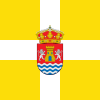La Puebla de Arganzón facts for kids
Quick facts for kids
La Puebla de Arganzón
|
|||
|---|---|---|---|
|
Municipality and town
|
|||

View of La Puebla de Arganzón, 2008
|
|||
|
|||
| Country | Spain | ||
| Autonomous community | |||
| Province | |||
| Comarca | Comarca del Ebro | ||
| Seat | La Puebla de Arganzón | ||
| Government | |||
| • Type | Mayor-council government | ||
| Area | |||
| • Total | 18.87 km2 (7.29 sq mi) | ||
| Elevation | 481 m (1,578 ft) | ||
| Population
(2018)
|
|||
| • Total | 495 | ||
| • Density | 26.23/km2 (67.94/sq mi) | ||
| Time zone | UTC+1 (CET) | ||
| • Summer (DST) | UTC+2 (CEST) | ||
| Postal code |
09294
|
||
La Puebla de Arganzón (also called Lapuebla de Arganzón) is a small town and municipality in Spain. It is located in the province of Burgos, which is part of the Castile and León region. The town is found in the Comarca del Ebro area.
In 2009, about 529 people lived in La Puebla de Arganzón. The municipality covers an area of about 18.87 square kilometers (7.29 sq mi).
La Puebla de Arganzón and a nearby municipality called Condado de Treviño form a special area. This area is known as the enclave of Treviño. It is part of Burgos province but is completely surrounded by the Basque province of Álava.
The municipality of La Puebla de Arganzón includes two main places. The larger one is La Puebla de Arganzón itself. The other is a small rural community called Villanueva de la Oca.
Contents
History of La Puebla de Arganzón
Before the current town, there was an older settlement named Arganzón. It was about one kilometer away from where La Puebla is today. Records show it existed as early as the year 871. However, this older settlement disappeared by the 1700s.
The town of La Puebla de Arganzón was founded much later. This happened around the end of the 12th century. At that time, there were many wars between the kingdoms of Castile and Navarre.
In 1191, the town received a special document called a fuero. This document gave the community certain rights and rules. Some historians believe the fuero was given by King Sancho VI of Navarre. He was also known as "Sancho the Wise."
A large part of the old town from the Middle Ages still exists today. It has a unique boat shape, stretching from north to south. In recent years, the town has grown with new buildings and more people.
Population Changes Over Time
The number of people living in La Puebla de Arganzón has changed throughout history. Here is a look at the population at different times:
| Historical population | ||||||||||||||||||||||||||||||||||||||||||||||||||||||||
|---|---|---|---|---|---|---|---|---|---|---|---|---|---|---|---|---|---|---|---|---|---|---|---|---|---|---|---|---|---|---|---|---|---|---|---|---|---|---|---|---|---|---|---|---|---|---|---|---|---|---|---|---|---|---|---|---|
|
|
|
||||||||||||||||||||||||||||||||||||||||||||||||||||||
| Source: 2001, 2004, 2008 | ||||||||||||||||||||||||||||||||||||||||||||||||||||||||
La Puebla de Arganzón in Stories
La Puebla de Arganzón has even appeared in famous Spanish books! A fictional hero named Salvador Monsalud was from this town. He was a main character in a series of ten books called Episodios Nacionales. These books were written by a famous Spanish author, Benito Pérez Galdós, between 1875 and 1879.
See also
 In Spanish: La Puebla de Arganzón para niños
In Spanish: La Puebla de Arganzón para niños



